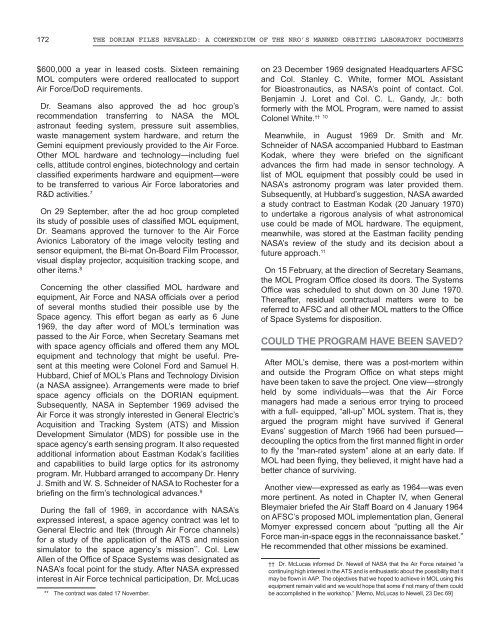NRO-MOL_2015
Create successful ePaper yourself
Turn your PDF publications into a flip-book with our unique Google optimized e-Paper software.
172 The Dorian Files Revealed: a Compendium of the <strong>NRO</strong>’s Manned Orbiting Laboratory Documents<br />
$600,000 a year in leased costs. Sixteen remaining<br />
<strong>MOL</strong> computers were ordered reallocated to support<br />
Air Force/DoD requirements.<br />
Dr. Seamans also approved the ad hoc group’s<br />
recommendation transferring to NASA the <strong>MOL</strong><br />
astronaut feeding system, pressure suit assemblies,<br />
waste management system hardware, and return the<br />
Gemini equipment previously provided to the Air Force.<br />
Other <strong>MOL</strong> hardware and technology—including fuel<br />
cells, attitude control engines, biotechnology and certain<br />
classified experiments hardware and equipment—were<br />
to be transferred to various Air Force laboratories and<br />
R&D activities. 7<br />
On 29 September, after the ad hoc group completed<br />
its study of possible uses of classified <strong>MOL</strong> equipment,<br />
Dr. Seamans approved the turnover to the Air Force<br />
Avionics Laboratory of the image velocity testing and<br />
sensor equipment, the Bi-mat On-Board Film Processor,<br />
visual display projector, acquisition tracking scope, and<br />
other items. 8<br />
Concerning the other classified <strong>MOL</strong> hardware and<br />
equipment, Air Force and NASA officials over a period<br />
of several months studied their possible use by the<br />
Space agency. This effort began as early as 6 June<br />
1969, the day after word of <strong>MOL</strong>’s termination was<br />
passed to the Air Force, when Secretary Seamans met<br />
with space agency officials and offered them any <strong>MOL</strong><br />
equipment and technology that might be useful. Present<br />
at this meeting were Colonel Ford and Samuel H.<br />
Hubbard, Chief of <strong>MOL</strong>’s Plans and Technology Division<br />
(a NASA assignee). Arrangements were made to brief<br />
space agency officials on the DORIAN equipment.<br />
Subsequently, NASA in September 1969 advised the<br />
Air Force it was strongly interested in General Electric’s<br />
Acquisition and Tracking System (ATS) and Mission<br />
Development Simulator (MDS) for possible use in the<br />
space agency’s earth sensing program. It also requested<br />
additional information about Eastman Kodak’s facilities<br />
and capabilities to build large optics for its astronomy<br />
program. Mr. Hubbard arranged to accompany Dr. Henry<br />
J. Smith and W. S. Schneider of NASA to Rochester for a<br />
briefing on the firm’s technological advances. 9<br />
During the fall of 1969, in accordance with NASA’s<br />
expressed interest, a space agency contract was let to<br />
General Electric and Itek (through Air Force channels)<br />
for a study of the application of the ATS and mission<br />
simulator to the space agency’s mission ** . Col. Lew<br />
Allen of the Office of Space Systems was designated as<br />
NASA’s focal point for the study. After NASA expressed<br />
interest in Air Force technical participation, Dr. McLucas<br />
** The contract was dated 17 November.<br />
on 23 December 1969 designated Headquarters AFSC<br />
and Col. Stanley C. White, former <strong>MOL</strong> Assistant<br />
for Bioastronautics, as NASA’s point of contact. Col.<br />
Benjamin J. Loret and Col. C. L. Gandy, Jr.: both<br />
formerly with the <strong>MOL</strong> Program, were named to assist<br />
†† 10<br />
Colonel White.<br />
Meanwhile, in August 1969 Dr. Smith and Mr.<br />
Schneider of NASA accompanied Hubbard to Eastman<br />
Kodak, where they were briefed on the significant<br />
advances the firm had made in sensor technology. A<br />
list of <strong>MOL</strong> equipment that possibly could be used in<br />
NASA’s astronomy program was later provided them.<br />
Subsequently, at Hubbard’s suggestion, NASA awarded<br />
a study contract to Eastman Kodak (20 January 1970)<br />
to undertake a rigorous analysis of what astronomical<br />
use could be made of <strong>MOL</strong> hardware. The equipment,<br />
meanwhile, was stored at the Eastman facility pending<br />
NASA’s review of the study and its decision about a<br />
future approach. 11<br />
On 15 February, at the direction of Secretary Seamans,<br />
the <strong>MOL</strong> Program Office closed its doors. The Systems<br />
Office was scheduled to shut down on 30 June 1970.<br />
Thereafter, residual contractual matters were to be<br />
referred to AFSC and all other <strong>MOL</strong> matters to the Office<br />
of Space Systems for disposition.<br />
Could the Program Have Been Saved?<br />
After <strong>MOL</strong>’s demise, there was a post-mortem within<br />
and outside the Program Office on what steps might<br />
have been taken to save the project. One view—strongly<br />
held by some individuals—was that the Air Force<br />
managers had made a serious error trying to proceed<br />
with a full- equipped, “all-up” <strong>MOL</strong> system. That is, they<br />
argued the program might have survived if General<br />
Evans’ suggestion of March 1966 had been pursued—<br />
decoupling the optics from the first manned flight in order<br />
to fly the “man-rated system” alone at an early date. If<br />
<strong>MOL</strong> had been flying, they believed, it might have had a<br />
better chance of surviving.<br />
Another view—expressed as early as 1964—was even<br />
more pertinent. As noted in Chapter IV, when General<br />
Bleymaier briefed the Air Staff Board on 4 January 1964<br />
on AFSC’s proposed <strong>MOL</strong> implementation plan, General<br />
Momyer expressed concern about “putting all the Air<br />
Force man-in-space eggs in the reconnaissance basket.”<br />
He recommended that other missions be examined.<br />
†† Dr. McLucas informed Dr. Newell of NASA that the Air Force retained “a<br />
continuing high interest in the ATS and is enthusiastic about the possibility that it<br />
may be flown in AAP. The objectives that we hoped to achieve in <strong>MOL</strong> using this<br />
equipment remain valid and we would hope that some if not many of them could<br />
be accomplished in the workshop.” [Memo, McLucas to Newell, 23 Dec 69]

















